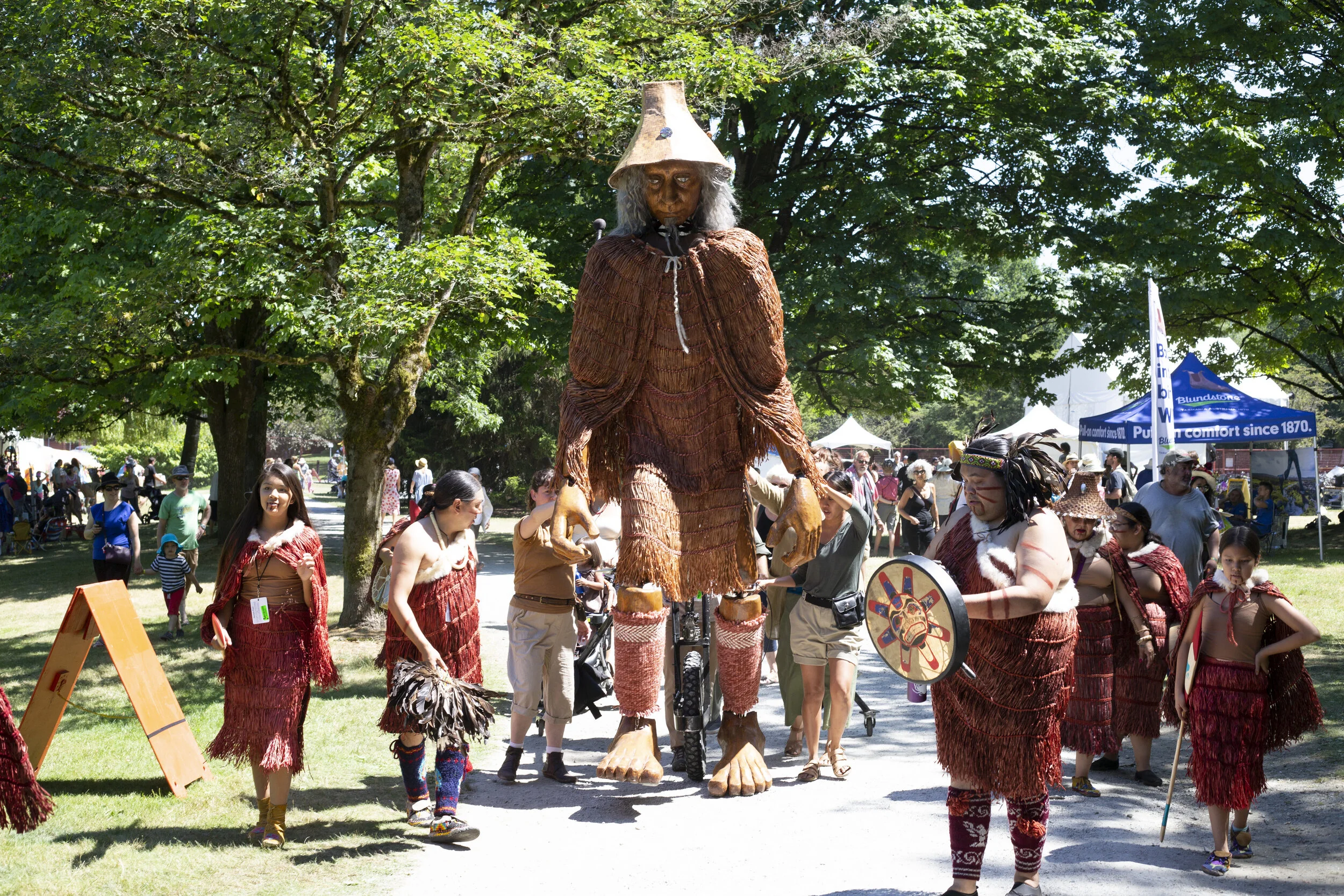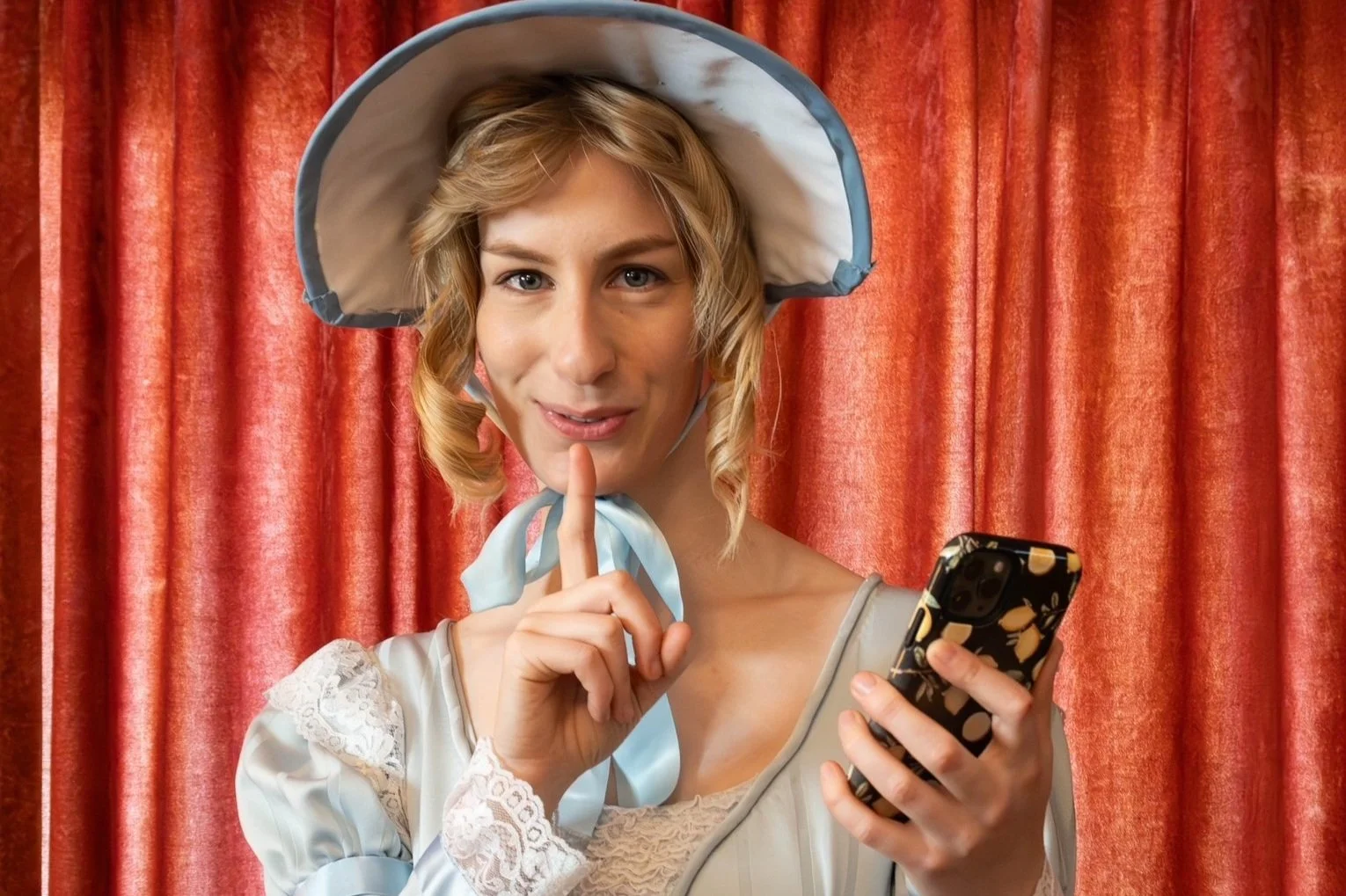Tsatsu Stalqayu (Coastal Wolf Pack) and Mortal Coil unite for a Grand Act of Great Hope
Storytelling, song, dance, masks, prayer, and puppetry mesh in Siiye'yu
(friends, relatives), presented by National Arts Centre English Theatre
Tsatsu Stalqayu (Coastal Wolf Pack, pictured at Vancouver Folk Music Festival) is a family group of Coast Salish singers, drummers, and dancers. Photo by Tim Matheson
A Grand Act of Great Hope—Siiye'yu (friends, relatives) by Tsatsu Stalqayu (Coastal Wolf Pack) and Mortal Coil Performance took place at on Sən̓aʔqʷ (Vanier Park) on July 8. The performance will be shared online by its presenter, National Arts Centre English Theatre. .
IN CREATING GRAND acts of Great Hope, the National Arts Centre English Theatre put forth a call for new works that would inspire audiences for the safe post-pandemic return to the performing arts. In response, Tsatsu Stalqayu (Coastal Wolf Pack) and Mortal Coil Performance joined forces for Siiye'yu (friends, relatives), a ground-breaking work that celebrates the Coast Salish people, their ancestral land, and the animals who call it home.
Tsatsu Stalqayu (Coastal Wolf Pack) is a three-generation family group of Coast Salish singers, drummers, and dancers; the members of Tsarlip First Nation are of all ages. Mortal Coil creates theatre and spectacle through stilts, masks, puppetry, and fantastical costuming.
The two groups have been working together since 2011, when Tsatsu Stalqayu (Coastal Wolf Pack) performed traditional Coast Salish songs and dances in Mortal Coil’s site-specific theatrical production Salmon Row. They collaborated again on The Faerie Play in 2015, with Tsatsu Stalqayu (Coastal Wolf Pack) as designers and performers.
Taking place at Sən̓aʔqʷ (Vanier Park), Grand Acts of Great Hope—Siiye'yu (friends, relatives) unites Tsatsu Stalqayu’s traditional Salish performance with Mortal Coil’s European-based site-specific theatrical techniques. The work features puppets such as a 12-foot-tall Salish elder called M’eh and other living creatures along with a thoughtful combination of storytelling, song, dance, masks, prayer, procession, and other elements.
The artists’ goal is multifold. “There are three major things we hope to do: honour the natural world we are standing on, make Tsatsu Stalqayu and the Coast Salish culture as visible as possible, and to celebrate our long collaboration through showing that the two cultures can get along and work together,” says Iona Paul of Tsatsu Stalqayu (Coastal Wolf Pack). “Tsatsu Stalqayu (Coastal Wolf Pack) didn't know anything about theatre and when this all started, it was very exciting to all of us that Mortal Coil wanted to work with us. And then, when we would sit around our kitchen tables and talk about what we might do together, we would get really excited about what might be possible coming from working together.
“The puppets that we have made together are very important to us,” she adds. “From the little owls to 12-foot M’eh, they are all very powerful living beings, and being able to make them using our techniques with Mortal Coil’s was a big step in our working together. M'eh especially has such a strong purpose and I am so proud of him and the regalia that I made for him. That regalia was in important part of my development as an artist.”
Grand Acts of Great Hope was co-curated by NAC English Theatre artistic director Jillian Keiley and Boca del Lupo Artistic Director Sherry J Yoon. Performed safely in front of live, local audiences in B.C., Alberta, Saskatchewan, Ontario, and Nova Scotia, the shows will be later shared online. Along with Paul, the local event’s core creative team and directors are Alec Dan and Peter Hall.
Hall, Mortal Coil’s artistic director, explains that early on in its work with Tsatsu Stalqayu (Coastal Wolf Pack), it was immediately clear that the group soared in presenting elements of their culture in a concert of traditional songs, dance, and narration.
“And while they did excel in this form, they expressed to us the desire of the family to expand their reach and share their stories with a wider audience,” Hall says. “To do this, they recognized the need to go outside their familiar format and to take some chances by telling traditional stories through other forms. We discussed how we might do this together and I felt, and continue to feel, that the challenge is to introduce European theatrical techniques without losing or compromising Coash Salish traditional art and expression. What I discovered from our very first production together was that we actually share so much theatrical perspective and ideas, and are finding the ways to bring those together.”
Through a synthesis of mask, puppets, song, dance, and narration, the two organizations ended up creating a unique form of story theatre, Hall explains. It tells a creation story that came directly from the Paul family’s oral history.
Another challenge and an opportunity of the collaboration, Hall says, was to always consider that the many children in the family hold an equal place in the presentations as adults. “It’s a challenge, sure, because kids and babies are at rehearsals can be distracting but it is an opportunity because what we to get see in rehearsal as well as in performance is the process of teaching and learning that is so much part of the day-to-day Salish culture.”
Iona Paul is a member of Tsatsu Stalqayu (Coastal Wolf Pack).
For Paul, it’s paramount that audiences—white settlers in particular—witness the children performing. The production comes on the heels of National Indigenous History Month and recent examples of the long-hidden reality and horror of residential schools.
“Our community doesn’t want any pity from white people,” Paul says. “It took finding those babies in the ground for everyone to believe us when we told you about the horrors of residential school—now you have to get out of the way and just listen.
“At the event on the 8th, it is important to me that the audience, especially the white audience, sees our children and grandchildren perform,” she says. “People are visual, and when they see our kids with us, it will help them understand even better what was lost through the killing of all of those children and that it was Native kids like those that they are watching that are in all those graves. Our kids and grandkids will show them what could have been.”
The artists see the performance itself a great act of hope—including the hope of building bridges between people.
For Marietta Kozak, Mortal Coil’s general manager, working with Tsatsu Stalqayu (Coastal Wolfpack) has been “revelatory, complicated, off balancing, and completely unforeseeable”.
“It is the most fun we've ever had in one of the many creation processes we’ve been involved in, and also the least predictable—which is part of what makes it so much fun….The work we've been doing together has all been organically generated. We seem to have found each other at the right time for both groups to be pushed and to learn from each other's cultures. It’s quite magical.
“Every time we perform with the Coastal Wolf Pack it is moving,” she says. “To see their stories told and songs sung in pre-contact regalia has such a potent sense of hope and resilience and trust that it is very emotional and special. I guess that all of us are hoping that the work we do together shows that the Coast Salish people are here, strong and undeniable. Mortal Coil is incredibly honoured to be part of this journey.”
For more information, visit Mortal Coil Performance.https://www.mortalcoil.bc.ca/















